The History of Comics: Decade by decade
New events that shape the comics industry are always happening. While the foundations of today’s industry started in the 1920’s, the events of today are shaping the industry of tomorrow.
Some events listed below are significant for their impact at the time but also for what they continue to do today however, some of what I will talk about was important once but has faded in time but still hold sway over the industry today. One element is clear in all these events, the importance lies in not only what occurred but when they occurred.
With the current dilution of the audience and the saturation of the marketplace by pop culture distractions, most events that shaped the medium would not have the same effect if they had been introduced today. With that in mind, this article will cover the important events of the times as well as the unrecognized events that have had significant long-term effects.
1920’s
Comics material had been in existence before the turn of the century but it was not until 1929 when The Funnies #1 (Dell) was published. The funnies was the first collection of comics material but it was more like a color newspaper supplement, as it had no cover, rather than the comic book format familiar today. Before 1929, almost all comics were part of magazines, newspapers or supplements and were not sold separately. While The Funnies was the first collection and definitely became a guide for later comics, it bares about as much resemblance to the modern comic book as the first steam powered vehicles from the 18th century do to modern day cars.
Most comic characters from the 20’s were created for newspaper strips rather than for stand-alone books. It is sad to look at characters from this period and see how few have survived to modern days. There were literally hundreds of characters and strips from the start of the 20th century’s first two decades but only a handful ever made the jump into comic books and fewer still are known to any degree today. Gasoline Alley was a hugely popular strip in its day and while it is not the monster hit it once was, it can still be found in the newspaper comics section today. The biggest on that list of survivors are Tintin by Herge, Buck Rogers, Popeye and Tarzan none of whom draw the readers like they did in their heyday.
1930’s
The 1930’s was the start of the Golden Age of comics. This was when the seed of everything we know in comics today were first planted. There are several key events and characters from the 30’s that shaped the formation of modern comics.
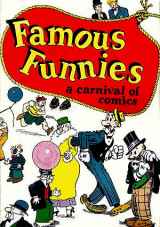 In 1933 Famous Funnies: A Carnival of Comics (Eastern Color Printing) was released. It was the first publication to resemble what we know today as a comic book, by including a cover and full color interior pages. Famous Funnies: A Carnival of Comics was given away or sold (we don’t actually know) at Woolworth’s department store. It was followed by Famous Funnies #1 in 1934 which was a large size format with 68 pages and sold for 10 cents each. Keep in mind the average persons’ take-home pay was less than $25/week and in the depression a dime could buy a meal. Even with its high cost, the first issue still sold over 180 thousand copies.
In 1933 Famous Funnies: A Carnival of Comics (Eastern Color Printing) was released. It was the first publication to resemble what we know today as a comic book, by including a cover and full color interior pages. Famous Funnies: A Carnival of Comics was given away or sold (we don’t actually know) at Woolworth’s department store. It was followed by Famous Funnies #1 in 1934 which was a large size format with 68 pages and sold for 10 cents each. Keep in mind the average persons’ take-home pay was less than $25/week and in the depression a dime could buy a meal. Even with its high cost, the first issue still sold over 180 thousand copies.
New Fun Comics (later More Fun Comics) #1 (National Allied Publications, which would later become DC) was published in 1935 and was the first comic that contained all new material. This title would later see the first appearances of such characters as Doctor Fate, The Spectre, Green Arrow, Aquaman and Superboy. New (More) Fun was the very first DC comic, and set in motion the comics industry we know today.
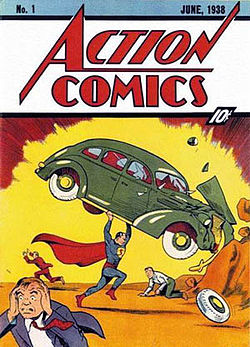 The most significant event of the 1930’s could be summed up as ‘the undies on the outside’. In the year between the cover dates of June 1938 and May 1939, the two most important characters in the history of comics first appeared. Obvious? Yes, but the importance of Superman and Batman to comics and many other mediums cannot be overemphasized. At the time of their first appearances, they were both hits. When Superman crossed over from comic books to comic strips, his appeal went from just kids reading the books to entire families reading his adventures in the daily newspaper. Once radio started featuring Superman’s adventures, the pop culture explosion began. Batman was every bit as big a hit when he started. There is nothing in modern popular culture that compares to the phenomenon of Superman/Batman. It is unlikely that if these characters (or something equally game-changing) were created today they would have the impact they did in the 1930’s. However to be fair, nothing even close to this revolutionary has been created in any medium for a very long time.
The most significant event of the 1930’s could be summed up as ‘the undies on the outside’. In the year between the cover dates of June 1938 and May 1939, the two most important characters in the history of comics first appeared. Obvious? Yes, but the importance of Superman and Batman to comics and many other mediums cannot be overemphasized. At the time of their first appearances, they were both hits. When Superman crossed over from comic books to comic strips, his appeal went from just kids reading the books to entire families reading his adventures in the daily newspaper. Once radio started featuring Superman’s adventures, the pop culture explosion began. Batman was every bit as big a hit when he started. There is nothing in modern popular culture that compares to the phenomenon of Superman/Batman. It is unlikely that if these characters (or something equally game-changing) were created today they would have the impact they did in the 1930’s. However to be fair, nothing even close to this revolutionary has been created in any medium for a very long time.
With the possible exception of Mickey Mouse, whose star has faded considerably in recent decades, Superman and Batman are the only icons that cross over all cultural, ethnic and social divides to be instantly recognizable. The money made from these two characters in print, film and merchandising is in the billions. The DC comics empire and a large part of the Warner Brothers film studio would be very different today if not for these two guys in tights. As for the comics medium, it is very likely that without the advent of the super-hero there would be no comic book industry today.
There were many publishers that started up in the 1930’s, of them DC (then called National Allied) and Marvel (then called Timely) were just small islands in the publishing ocean that they shared with Dell, Centaur, McKay, Eastern Color, Fawcett (more on them in a bit) and many others. Of the companies active in comics publishing in the 30’s only Marvel and DC exist as comics publishers today. Most of the rest went out of business entirely, stopped making comics or were absorbed by other companies.
1940’s
There really is only one major event to consider from the 1940’s, World War II. While the War itself was a terrible thing, it had a few positive affects on the comic book industry. One of the biggest short-term effects was the need for reading material for the troops stationed overseas. Nearly 30% of reading material sent to deployed soldiers were comic books. The soldiers looked forward to the diversion and escapism of comics and the quality of the material was never as important as the connection to home that troops felt from reading these stories.
Another important effect that had longer lasting ramifications was the paper drives during the war. Paper was in high demand since everything from explosives and flares to the boxes used to transport supplies required paper. Almost any paper, such as old newsprint, was needed for the war effort, and comic books were not exempted. The collection and subsequent destruction of so many comics had an astonishing long-term effect on the collector’s market. Just think, without the paper drives during the war the number of Golden Age books available to the collectors market today could be staggering. For example, Action Comics #1 (the most valuable comic at $2.1 million at recent auction) is incredibly rare with estimates of less than 100 copies remaining. Out of those 100, only six copies are registered that list as ‘fair’ or better condition (to put that in perspective, the original print run was about 200,000). How many would exist today if not for the paper drives? The available quantity of Golden Age books would be incalculably higher than what it is today and the collecting industry would be a very different looking animal indeed.
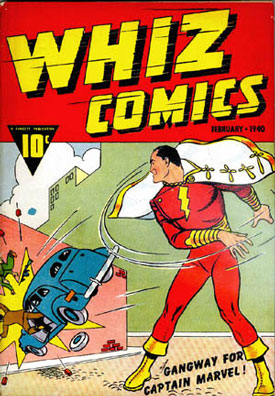
Other than the political effects of the war, the 1940’s saw the creation of a great many characters, the most popular of which at the time was Captain Marvel. Regularly outselling Superman was what ultimately doomed the ‘Big Red Cheese”, as he was affectionately called, to relative obscurity. Copyright infringement lawsuits lasting years ultimately killed the character and Fawcett Publications, his publisher at the time. It wasn’t until the 1960’s when DC Comics, the winner of the lawsuits, bought Fawcett and the re-published him as SHAZAM (meanwhile, Marvel Comics had created and trademarked the name Captain Marvel as a new character). SHAZAM enjoyed some popularity but he has never been as interesting to mainstream fans as he was as the original Captain Marvel. As another odd effect felt because of the lawsuit between Fawcett and DC (finally settled in 1953) was that since Captain Marvel was gone from comics there were voids in books needing to be filled. This included his British books, which were usually reprinting of older tales printed for Great Britain. The void created by Captain Marvel’s disappearance was filled by a just barely disguised copycat called Marvelman. Marvelman became Miracleman but is now Marvelman again and we might one day see his adventures continued. The legal battle created by the DC/Fawcett issue created the Marvelman legal battles, and comics readers are still feeling the effects today.
 The character from the 1940’s with the longest-lasting effect would have to be another captain, Captain America. While a reasonable hit in the war years, Cap’s popularity began to fade and his adventures stopped entirely in 1949. After a few awful attempts at revival in the 50’s it seemed that the character was dead. When Marvel decided to bring the character back as a member of the Avengers in 1964, Cap’s popularity was assured and he is a major factor in Marvel’s continuing success today.
The character from the 1940’s with the longest-lasting effect would have to be another captain, Captain America. While a reasonable hit in the war years, Cap’s popularity began to fade and his adventures stopped entirely in 1949. After a few awful attempts at revival in the 50’s it seemed that the character was dead. When Marvel decided to bring the character back as a member of the Avengers in 1964, Cap’s popularity was assured and he is a major factor in Marvel’s continuing success today.
1950’s
The middle decade of the last century was not a good one for the comics industry. After the War, sales dropped dramatically and then continued to slide down throughout the 1950’s. Super heroes all died out between 1950 and 1955 with only Superman, Batman and Wonder Woman (and a few smaller ones) still being published. While the super hero was faltering, other genres began to surge in popularity. Western, romance, crime, horror and science fiction comic books all became immensely popular. It was the sudden rise in popularity experienced by crime and horror comics, coupled with an increase in juvenile delinquency that gave rise to Fredric Wertham and his crusade against comics.
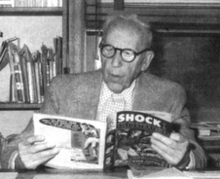
Dr Wertham was a psychiatrist who was against comics. He perceived a link between them and juvenile delinquency but his conclusions were based on anecdotal evidence and generally amounted to the same thing that comes up in society every few years when ‘well-meaning and right thinking’ people are afraid of something. “X is a bad influence on Y, which is why Z happens”. Generally items filling in X are popular culture such as books, movies, TV and video games, and Y is always either children or mentally disturbed people. Z rarely has any real link to X or Y beyond an imagined one. As it always happens when people see something they don’t like or can’t explain those who know better than all of us ignorant sheep want to be allowed to tell us what to do, read, think or believe. Unfortunately for comics, this time it worked.
Wertham testified at hearings on Capitol Hill that, along with his book Seduction of the Innocent, resulted in the comics industry creating a self-censoring body called the Comics Code Authority. The CCA’s new rules caused virtually all crime, horror and dark fantasy comics to either cease publication or become so sanitized as to be unreadable. Many publishers (Ace, Avon, Fiction House and Mainline) simply closed their doors as a result of the new restrictions. EC Comics survived only by converting the comic book MAD into a magazine size format, which was exempted from the CCA. Under the new rules any comic that was even remotely controversial suffered and became like an episode of Ozzie and Harriet. This sanitization of the product only made the decline in sales worse.
Today the CCA is almost completely forgotten and has not been followed consistently by the major publishers for many years. Marvel dropped it completely in 2001 with DC and Archie following in 2010. The only lasting effect the code has had is the damage it inflicted on the industry as a whole.
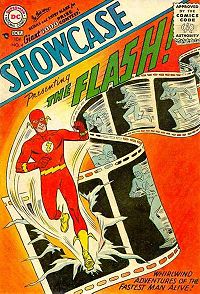
The 1950’s are not a total loss. In 1956, Julie Schwartz started the Silver Age of comics. Not really, but Showcase #4 (DC) is considered the start of the Silver Age by collectors today and that was Julie’s baby. Under Schwartz’s editorial direction, DC entered the Silver Age with many classic characters revitalized with new origins and updated identities tuned to the modern audience of the 50’s. Today most of these great characters are still around, and thriving (Flash, Green Lantern and the Atom). Virtually all the current DC characters are from the Silver Age of the 1950’s and the ‘New 52’ would be closer to the ‘New 25’ if not for the characters created or revamped during the Silver Age.
1960’s
The 1960’s was a time of significant growth in the comics industry. There would never again be the heyday of the Golden Age but the now well underway Silver Age was allowing more and more comics to be published.
The 60’s saw the first major comic book conventions start up and gain popularity. There was no major media presence or movie previews also absent were the panels and special guests or any kind of celebrity status for industry people. The cons were all about dealer’s tables and selling/buying comics. It would be several years before there was even an Artist Alley at most cons. Today San Diego and New York’s comic cons are huge events and multimedia showcases with comics being pushed to the side in favor of movies, video game, toys and celebrities.
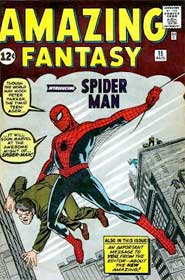
In print, Atlas comics became Marvel comics and began publishing a new group of titles like Fantastic Four, The Avengers, Hulk and Spider-Man. Trying to pick the most important of the Marvel books of the 60’s is like nailing Jell-O to a tree. What is clear about this time in the history of comics is that Marvel was starting to grow and develop while DC was starting to falter. The restrictive distribution arrangement Marvel had for its books (A company owned by DC was in charge of the distribution and restricted Marvel to eight titles a month) kept them from exploding in popularity but the writing was on the wall for DC.
In 1967 something very odd happened; National Periodical Publications (not yet officially named but often called DC) was purchased by a parking lot company called Kinney National. Along with NPP, Kinney also purchased a talent agency, Panavision and Warner Brothers-Seven Arts. It didn’t take Kinney long to dump the parking lots in favor of the media arm and Warner Communications was born. Today, the Warner empire is huge and the comics end of the business is responsible for a major portion of the company’s success in the last two decades.
As for the most important character of the 60’s I think the clear choice is Xemnu from Journey into Mystery #62.
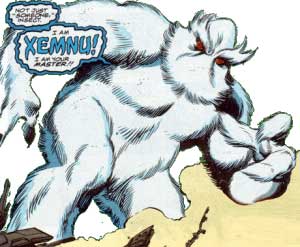
(Just kidding. I’m just trying to give the D-list 60’s characters some love.) Picking the most important character of the decade is nearly impossible; there are just too many great and lasting ones. I think a likely candidate from that time would be Spider-Man. Spidey was a huge success for Marvel and remains a major draw today. The sleeper of the era was X-Men, a title that limped along for many years until it was canceled. Once revived in the 1970’s however, the Uncanny X-Men was a sleeper again but this time the fans were starting to notice. Eventually the X-Men franchise would become Marvel’s largest and most recognizable but it took a long time to get there.
1970’s
By the time the 1970’s were in full swing, Marvel had taken the number one spot from DC and was widening that lead. The major cancellation of DC books that came to be called The DC Implosion hurt the publisher both in terms of money and readership. Unfortunately the quality of the books Marvel was releasing was dropping. Very little supervision of the talent meant that just about anything was getting printed and the company was not making very much money even with the new lead. As much as editorial interference is grumbled about these days, the editors do serve a purpose and the absence of editorial control was obvious in some of the Marvel titles.
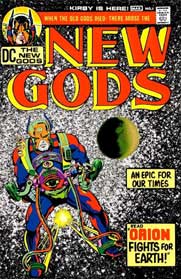 Meanwhile, Jack Kirby left Marvel for DC where he created what would become The Fourth World. At the time, DC was not all that happy with the titles Mister Miracle, The New Gods and The Forever People or the sales generated by them. Part of the problem was the way DC and comic companies in general determined the sales of a book. There was a severe delay in understanding how well a book was selling. Companies had to wait a few months until the returns came in so they could tell how many actually sold from the print run. By the time DC realized the three titles were selling reasonably well they were starting the process of canceling the books and none of the three made it past 25 issues. Interestingly, integrated into the DC universe and revived in the 80’s, the New Gods characters are now a major part of DC and the New 52.
Meanwhile, Jack Kirby left Marvel for DC where he created what would become The Fourth World. At the time, DC was not all that happy with the titles Mister Miracle, The New Gods and The Forever People or the sales generated by them. Part of the problem was the way DC and comic companies in general determined the sales of a book. There was a severe delay in understanding how well a book was selling. Companies had to wait a few months until the returns came in so they could tell how many actually sold from the print run. By the time DC realized the three titles were selling reasonably well they were starting the process of canceling the books and none of the three made it past 25 issues. Interestingly, integrated into the DC universe and revived in the 80’s, the New Gods characters are now a major part of DC and the New 52.
Looking back, the largest event of the 70’s was the creation of the direct market in the middle part of the decade. Previously, comics were distributed through the main periodical distribution system run by a few companies to newsstands, drugstores and candy shops. There was a small subscription system but the bulk of comics sold were from the newsstand type locations. These retailers could return unsold comics for credit (just the ripped off covers were returned and the rest was supposed to be discarded) towards the next purchase. It was this new distribution system that helped encourage the growth of specialty shops, which offered several benefits to the customer. Speed of service was improved since the direct shops got the books quicker which was very popular with readers. The condition of the books was also generally better than what was found on the newsstands or in subscription copies. The retailers liked it because they made more profit on the books in exchange for not being able to return them. They could also continue to sell comics as back issues and keep money coming in.
The problem with the direct market was that it was only created as a temporary substitute for the failing newsstand system. There was no plan for what would follow the direct system, just that there would need to be a replacement eventually. Foolishly, the publishers put all their eggs into this particular basket and by the 1990’s sharp increases in the number of stores closing and sales of books dropping had severe ramifications. The creation of the specialty shops had stunted the potential for growth with new readers shying away from or not having access to these locations. The industry today is down to one primary distributor (Diamond) where there were once many. Bookstores and digital comics also take a chunk out of the direct market and this ‘temporary solution’ is starting to show the nearly four decades worth of cracks.
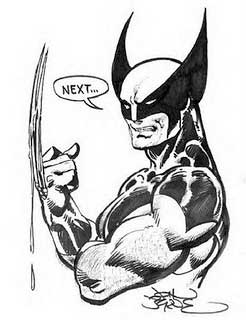 The list of new characters in the 70’s is really something to see. Some of the first appearances of major characters known today were; the John Stewart Green Lantern, Power Girl (boob window optional at this point), Adam Warlock, Luke Cage and the most important’ bad characters of all, The Wonder Twins! However the character to debut and have the longest lasting impact from the 70’s has to be Wolverine. Created by Len Wein and Herb Trimpe, Mr. “I’m the best there is at what I do, but what I do isn’t very nice.” (Wolverine) has made a lasting mark on the comics industry and not all for the best. However, it wasn’t until Chris Claremont started writing Wolverine that the character developed true depth and feeling not to mention the hints of a ridiculously messed up back story. Wolverine also became the inspiration for a whole new crop of dark and gritty anti-heroes. Wolvie is now in every Marvel book printed and probably a few DC ones as well. OK, not really, but there are months where it sure seems like it.
The list of new characters in the 70’s is really something to see. Some of the first appearances of major characters known today were; the John Stewart Green Lantern, Power Girl (boob window optional at this point), Adam Warlock, Luke Cage and the most important’ bad characters of all, The Wonder Twins! However the character to debut and have the longest lasting impact from the 70’s has to be Wolverine. Created by Len Wein and Herb Trimpe, Mr. “I’m the best there is at what I do, but what I do isn’t very nice.” (Wolverine) has made a lasting mark on the comics industry and not all for the best. However, it wasn’t until Chris Claremont started writing Wolverine that the character developed true depth and feeling not to mention the hints of a ridiculously messed up back story. Wolverine also became the inspiration for a whole new crop of dark and gritty anti-heroes. Wolvie is now in every Marvel book printed and probably a few DC ones as well. OK, not really, but there are months where it sure seems like it.
1980’s
The explosion of new publishers in the comics industry immediately marked the 1980’s as a creative high point. New publishers were coming out of the woodwork boasting new creator owned series by some of the top names in the industry and by new ‘up and coming’ creators. Among the many comics and publishers are Capital Comics (Nexus and Badger), Pacific Comics (The Rocketeer, Groo and Jack Kirby’s Captain Victory), First Comics (American Flagg! and Jon Sable, Freelance), Comico (Mage and Grendel), Eclipse Comics-actually the late 70’s but they didn’t really get going until the 80’s (Miracleman, Zot! and DNAgents) and of course Dark Horse Comics. It is a bit sad that along with many others I have not named here, none of the new publishers that appeared in this period exist today except for Dark Horse.
The breakthrough works of many creators came from the 1980’s. Matt Wagner, Alan Moore, Neil Gaiman, Steve Rude, Dave Stevens, Mike Grell, Scott McCloud, Frank Miller and John Byrne were new or not previously well-known creators when they hit it big time in the 80’s.
The most significant event of the 1980’s is almost certainly the entire year of 1986. Specifically late 85 to early 87, but let’s not get nit-picky. The list of classic series and graphic novels that started up in this 18 month period is absolutely jaw-dropping.
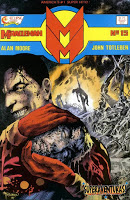 Miracleman by Alan Moore debuted in the US from Eclipse comics (it had previously been started in the UK in the magazine Warrior) and would later be written by Neil Gaiman after Moore departed.
Miracleman by Alan Moore debuted in the US from Eclipse comics (it had previously been started in the UK in the magazine Warrior) and would later be written by Neil Gaiman after Moore departed.
Frank Miller’s The Dark Knight Returns redefined the character of Batman for the modern world and inspired or informed every comic book movie since.
Maus by Art Spiegelman told the story of Spiegelman’s own family during the Second World War and later earned a Pulitzer Prize for Letters in 1991 once it was collected.
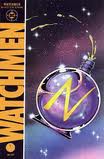 Watchmen by Alan Moore and Dave Gibbons became one of the most celebrated mainstream comic books in history and earned a place on Time Magazine’s list of the 100 greatest English language novels of the 20th century.
Watchmen by Alan Moore and Dave Gibbons became one of the most celebrated mainstream comic books in history and earned a place on Time Magazine’s list of the 100 greatest English language novels of the 20th century.
Daredevil: Born Again by Frank Miller and David Mazzucchelli revitalized a character that had not been done well since Miller had left the title a few years earlier and would not be done well again for several more years but this book is a masterpiece.
The Man of Steel by John Byrne rebooted Superman post-Crisis and was the basis for the entire next decade of Superman stories.
Speaking of Crisis, Crisis on Infinite Earths just squeaks in the time frame of this list and was the defining basis for everything DC for the next three decades.
More from Moore, Whatever Happened to the Man of Tomorrow by Alan Moore was also published. This was the only Crisis era story to address the pre-Crisis Superman, and is a hallmark of the era.
And to round out this list, Frank Miller and David Mazzucchelli brought us Batman Year One. A redefined origin for Batman and a story that seemed fresh and new for a modern world.
That list is not only good comics, it is an essential list for any comics fan. You almost cannot call yourself a true fan until you have read these books as all are important to the medium and in several cases, to literature itself. The fact that these are all from the same few month period is more than a little amazing; must have been something in the water.
1990’s
As I sat down to do the section on the 1990’s, I was concerned about having something positive to say as my recollection of the decade in comics was not a good one. I was surprised as I started to look into the 90’s more (I had to do some serious research as I was not very ‘into’ comics during this period once things really going pear-shaped) and found that there were some decent books in the 90’s. It is just unfortunate that for every good book there was several more that were not so good.
Sometimes as we get farther away from events, it is easier to see the important ones amongst the fluff. Since the 90’s are still so recent, the events and their significance to the medium are still resolving. I think that the 90’s will be remembered for the creator revolution and the creative renaissance. When Jim Lee, Todd McFarlane, Erik Larsen and Rod Liefeld left Marvel to found Image Comics, there was a lot of talk about the inmates running the asylum. 20 years on, much of that was proven true. Image was a company that was poorly run by people that would have preferred making comics. As a result, the partners fell out with one another sometimes and eventually the company was absorbed by DC.
The really creative renaissance came about much more quietly. Dark Horse Comics and other small publishers led the way with top notch creators doing their own books and owning what they produced. Some of these were a resounding success (Frank Miller-Hard Boiled, Give Me Liberty, Sin City or John Byrne-Next Men) while some less so (Alan Moore and Bill Sienkiewicz-Big Numbers). However the major players had moments of near-greatness as well. DC created the Vertigo imprint as a home for the edgier, more adult material until Karen Berger’s recent exit from the company, was the absolute model of how to do creator owned books at a major company. DC had one of the biggest hits in the history of comics with The Death of Superman and despite what many thought at the time, this story has aged very well and continues to be a strong seller.
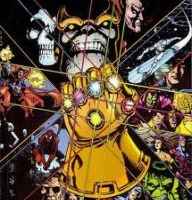 Marvel had great stories as well. The Weapon X series in the Marvel Comics Presents anthology redefined Wolverine and brought fans closer to understanding the characters origins. Marvel also made a splash with The Infinity Gauntlet and the stories that followed. It is very likely that these cosmic stories will play a large part as the basis in the next Marvel movie cycle.
Marvel had great stories as well. The Weapon X series in the Marvel Comics Presents anthology redefined Wolverine and brought fans closer to understanding the characters origins. Marvel also made a splash with The Infinity Gauntlet and the stories that followed. It is very likely that these cosmic stories will play a large part as the basis in the next Marvel movie cycle.
Unfortunately for all these great stories, there were huge embarrassments in the 90’s both in the books and behind the scenes. After the Image guys left Marvel, a series of bad financial choices left the company filing for bankruptcy protection. Marvel also lost one of its greatest assets not long before the Image defection when Chris Claremont, who was forced off the X-Books he had written for 17 years in favor of Jim Lee, left. Both major players has some serious missteps in books like NFL Superpro at Marvel and the ‘Electric Blue Superman’ story at DC that came off as sad attempt to do something different (but not really) or cash in on a trend.
Another blow to the industry was, after years of speculators collecting comics to get rich and completely missing what it was that made a comic valuable, the bubble burst taking with it the financial fortunes of the industry and many retailers as well.
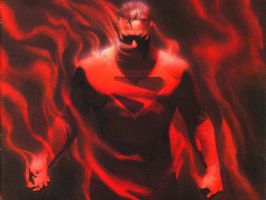 The 1990’s will go down as a dark time in the industry but not one completely without hope for the future. There are a few series from the 90’s that are reminders of just how good comics can be (Marvels, Kingdom Come) and can be viewed as a celebration of the great elements of classic characters the industry had either forgotten or made gritty and grim to attract a new audience.
The 1990’s will go down as a dark time in the industry but not one completely without hope for the future. There are a few series from the 90’s that are reminders of just how good comics can be (Marvels, Kingdom Come) and can be viewed as a celebration of the great elements of classic characters the industry had either forgotten or made gritty and grim to attract a new audience.
2000’s and beyond…
I thought on the last 12 years and realized it is a difficult task deciding what is important now and going forward. There are a few milestones as the industry has lost some of its brightest creators like Mike Wieringo, Dave Stevens and EC Comics great Johnny Craig along with many others. In the last year alone Jean ‘Moebius’ Giraud and Joe Kubert have been lost to us. What should have been the biggest event in many years, the end of Dave Sim‘s monumental run of Cerebus, came and went with hardly a notice by the comics industry. DC’s interesting attempt at webcomics, Zuda started with promise and failed to create any real buzz.
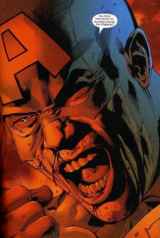
Marvel launched the Ultimate Universe, a supposedly continuity-light version of the standard Marvel U. After a dodgy start and a few missteps, things went well for a while but it didn’t take long however to be just as continuity driven as the rest of Marvel. There are still bright spots though, Miles Morales is the new Spider-man and the ultimate version of the Avengers is interesting enough that the Marvel movies are largely based on it.
It is those Marvel films that will likely be the most remembered of the decade. From Sony’s Spider-man films to Fox’s X-franchise all the way to the Marvel/Disney partnership, these films have been an outstanding success. Less successful were Fox’s attempt at The Fantastic Four and Daredevil franchises and while not dreadful, these films failed in most of the important ways; they failed to impress fans and were just not very strong films. The Marvel/Disney slate of films ended 2012 impressively with The Avengers and set up the start of the next cycle of films that starts with 2013’s Iron Man 3.
The surge in popularity of digital delivery systems for comics content has yet to surpass print in terms of sales but the market continues steadily to grow for digital comics and publishers are looking for any way to exploit that demand.
 I suppose the last ‘big thing’ of recent years is the 400 gorilla in the room; The New 52. Having read about half of the books at one point or another in the last year, I cannot say that much of merit has changed. Superman has become a bit more of a jerk or far more human, depending on which book you read. Batman and Green Lantern have not changed at all and most of the rest of the universe started with great promise but then quickly faded into the same old storytelling tropes as before. While some of the changes were needed over at DC in the last few years (like getting rid of all the Wildstorm books and folding them into the DCU) many have been just plain odd. The folding back into the DCU of characters like Constantine while canceling the Vertigo version just seems short-sighted to me.
I suppose the last ‘big thing’ of recent years is the 400 gorilla in the room; The New 52. Having read about half of the books at one point or another in the last year, I cannot say that much of merit has changed. Superman has become a bit more of a jerk or far more human, depending on which book you read. Batman and Green Lantern have not changed at all and most of the rest of the universe started with great promise but then quickly faded into the same old storytelling tropes as before. While some of the changes were needed over at DC in the last few years (like getting rid of all the Wildstorm books and folding them into the DCU) many have been just plain odd. The folding back into the DCU of characters like Constantine while canceling the Vertigo version just seems short-sighted to me.
I wish there was some great hope for revitalizing the industry in the coming years. While I’m not certain that one is needed, I do see a serious point of change coming. Everything with comics, from the creation and production to their distribution and merchandising is about to change. The question is, will it change and survive or change and simply fade away.
What do you think? Leave a comment.
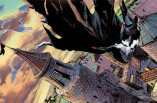

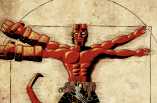
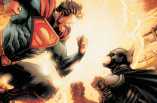

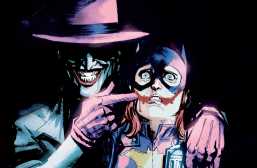
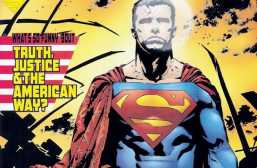
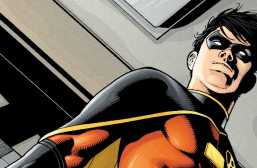
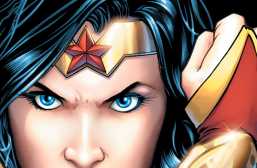
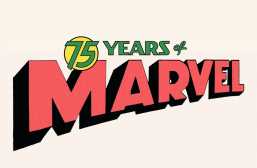
Holy! What a report we have here!! So interesting, mostly fascinated by the 1950s, didn’t know that they thought of comics the same as they do with video games, movies and whatnot. Stupid. Are there any Fredric Wertham clones today? Is comics targeted anything in this time period (like games still are, and some movies and tv)?
Well, there is the Million Morons, oops I mean Million MOMS! But other than that, nothing even close to the fervor of senate hearings. As long as there are places like FOX “news” to get people riled up and distracted by nothing, then comics are safe for a while. They will eventually get back around to comics as the next un-American evil thing though, dont worry. I read Seduction of the Innocent something like 20 years ago and the biggest parallel I can make to moronic ‘scientific’ or social arguments in today’s world would be all the ‘science’ behind ideas like the ‘women can prevent pregnancy from rape’ type arguments. There is every bit as much science there as were in Wertham’s book in the 50’s. It is a sad fact in the US today, that the loud morons are always listened to over the well spoken intelligencia.
that action comics #1 auction is unbelievable.
The really amazing thing is the prices that poor condition copies of Action #1 bring! I saw a copy that was held together by masking tape go for nearly $1000 not long ago!
Every decade has its bad and good but if I had to choose which I liked the most, it would be the 90’s for nostalgia reasons (it was my teen years). Thank you for the entertainment!
We all have the nostalgia bug. Mine was the early 80’s for the same reasons yours was the 90’s. I still read the 80’s books more than any other decade.
Okay, answer me this, why did you talk only about “superheroes”? You missed an entire group of comics that during World War II, and for a large number baby boomers, played a big role in our lives. You skipped “Dick Tracy”, “Archy” and that entire genre.
Now I realize they may not be considered major players if your world revolves around ‘action’, but in the 40’s, 50’s and 60’s they were a big influence.
Dick Tracy not so much as it did not sell all that well as a comic book but was bigger in strips, but Archie was HUGE during the era, and still sells well today. They were among the books that did well after the senate hearings damaged the rest of the industry. The more kid-friendly titles were about the only things to do well. Roy Rogers and Lone Ranger were 2 more that were very popular at the time, unfortunately they do not age well for a modern audience. Many of the western, romance and humor books of the 50s, and 60’s were not very interesting because of the interference of the CCA. One of these days I will do something in depth on each decade and really make my head hurt.
I find the Golden and Silver Ages the most fascinating times for comics.
We have had some really great runs the past 10 years like Batman, Daredevil, Captain America, Secret Six, Green Lantern, Gotham Central and more… The future doesn’t look that bleak!
I try to stay optimistic, but it is difficult. Batman is stretched too thin currently, only one really good book, Daredevil is a bright spot now, but really was mostly dark and awful until recently, Cap was not my kind of book, but it was very popular, GL is a bit hit and miss but still a strong book. But with secret Six and Gotham both cancelled for no good reason, I still despair. Every time a really strong run starts in the last few years something seems to derail it. I keep reading, but I still am uncertain about the industry and its future.
I agree on your comment re: Batman. Why is that series in the place where it is right now?
Thanks!
Thank you dearly for this. I am currently working on a thesis where I will be referencing to this post, do you have any particular referencing guides or can I go with date of publication, author and site address like other Harvard style of referencing. Thank you again!
-Daniel
Whatever referencing format you wish to use for the purposes of your thesis is fine. I would be interested in the thesis when it is finished also, if you feel like sharing.
Found this through Google and extremely glad that I did because there is a lot of crap articles on comic history, and this site has great posts man! Nothing in particular that I want to comment about, just planned to thank you for the post!
You are very welcome.
Keep reading, there is more to come!
Keep up the good work! Will be watching this space…
You know, I took an Intro to Graphic Novels course in college, and just packed way more info into my brain by reading this than I did that whole semester (though to be fair, I did gather a cool starter collection from the required reading). Nice article!
Would love to attend a Graphic Novels course. I had a tutor in university that had a was an avid comic book collector and he used to have a meeeental collection. He used to bring his latest finds and rant about them for 20 minutes straight, sometimes longer. It was like a fountain of knowledge… quite funny when I look back at it.
Great read, which makes me want to read more of the classic works from the 1980s in particular. I found it curious that you no mention of Neil Gaiman’s Sandman. Was there any reason for this?
Mostly because everyone and his brother makes note of the series, one of my favorites –the Absolutes all looks stunning on the bookshelf.
As important as Sandman was at the time and still is, I never felt that it was super new, a fact Gaiman himself has said on occasion. And the specific list in the 80s section was mainly a magical period around 1986.
Great article! Comic books seek to interpret a political or social issue and respond in kind with a intellectual message. X men , for example, has always discussed the ways in which minorities are treated. They reach out to the masses whilst containing relevant stories and likeable characters.
Thank you for this! A very complete report. My uncle and cousins are Marvel fans, and I remember looking at pictures in books and wondering who the hell were all these people (there are so many!). Your article has taught me much more on the story of comics, I can now have a proper conversation on the subject 🙂
Good read, thanks much! As far as the future of comics, love it or hate it, it’s all about the internet! The intense amount of webcomics out there grows each day. While not all of it is great, it is giving writers/artists the opportunity to gain audiences before having to spend money on print publishing.
I hope I never see the day where print is no longer sought after, but I do love the chance for so many newcomers to be seen without needing traditional distribution.
I disagree that things didn’t change much with the New52. DC destroyed its strong female characters. One thing I respect about Marvel is that they have a decent amount of diversity female personalities. Most of the main women in DC seem to be little more than sex objects lately. I really enjoyed down to earth characters like Stephanie Brown and Cassandra was super cool. Barbara as Oracle gave her more depth as a character. I also liked Lois Lane, Starfire and the scary Cadmus lady. Now all of these characters either don’t exist or are over-sexualized to the point of having no real depth at all. It’s like any new writers for DC are just a bunch of horney boys. I was really enjoying the direction of Batman before the relaunch. In my opinion, the New52 is one of the biggest disappointments in comic book history. Oh, and I want Wally West and Damian back as soon as possible. I feel like Damian Wayne was on his way to becoming one of the best DC characters in recent years.
Awesome article! The only thing is I was unable to find where you had stated where the bronze era was?
This is interesting, I will refer my students to it when doing research in this area.
Great article! There is a museum in Baltimore (Geppi’s Entertainment Museum) that celebrates pop culture, especially comics. I grew up on Archie Comics myself, and still adore them to this day. I appreciate the changes they have made, making the characters look more “realistic” with stronger story lines.
Very informative. I did not want to buy a book on the subject. This gives me a basic narrative of the history of comic books, and that is all I want. My only criticism is that you did not mention Ghost Rider or the Punisher in the 70’s decade. Both of those characters are still revelvant today and should be mentioned. I would also say something about Valiant comics, which does not have the same pop culture relvence as Marvel, D. C., or more importantly their respective characters, but it has relevence within the Comic book reading community.
this was so helpful! thankyou! (:D)
this was so helpful!i have a project to cn comics and this helped soooooooooo much! thankyou! (:D)
hi
hi
Nice information, helped me finish my ISP!!!
video games still better. im only reading this for school
video games still better. im only reading this for school hahahaha
This was a very good article which held my interest up until about the 1990s. I really like knowing about the early days of DC comics and Marvel comics and you did quite well covering the Golden age and the silver age of comics. Thank you for this article, it was quite in depth and well-informed.
The part about the Marvel movie universe was prophetic. They dominated the big screen in the 2010s.
yeeeeeeee it good
yup me to only for school vr much beta
lelelleleleleeleleleleleleleleleleleeleleelelelelelelelelel cant read
Great article! I would say, though, that John Byrne was as responsible as Chris Claremont for the increase in popularity of Wolverine, though he doesn’t share the blame in the ridiculously convoluted backstory. Some things are better left unknown!
Quite a few of the early comic strips were cute; I believe Blondie started during this time.
Super…. I am surprised you completely neglected Eisenr and Spigelman… But I may have missed them. Seams that to you Comics it is about super heroes only. Again: I may be wrong!
Thank for the post. I found it really interesting